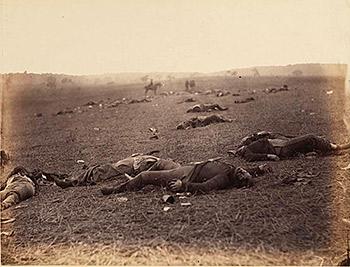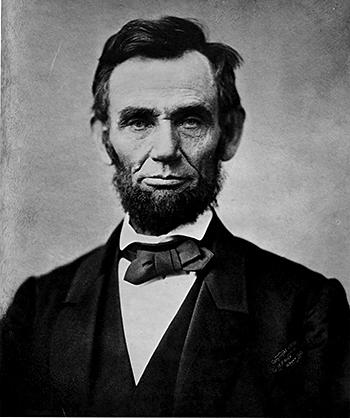This blog post inaugurates a monthly Eye Level feature on our upcoming exhibition The Civil War and American Art. Curator Eleanor Harvey will be talking about many of the important intersections between American art and the Civil War. The exhibition will open November 16 and run through April 28, 2013.

Timothy H. O'Sullivan's A Harvest of Death
The new medium of photography influenced the way people responded to the events of the Civil War. For the first time, Americans saw images of dead soldiers, their unburied bodies strewn across the landscape. In October 1862, Mathew Brady exhibited Alexander Gardner's photographs taken at Antietam in the days following the battle. The visceral brutality of these images shocked viewers and made it difficult to romanticize the conflict. In July 1863, Gardner and fellow photographer Timothy O'Sullivan took photographs of the dead at Gettysburg. O'Sullivan captured what is widely regarded as the most powerful image of the aftermath of this battle, which was titled A Harvest of Death.

Alexander Gardner; Abraham Lincoln, November 8, 1863; photographic print; Library of Congress, Prints and Photographs Division (LC-DIG-ppmsca-19301)
Abraham Lincoln understood the power of images to shape perceptions. Long before he was elected president Lincoln had himself photographed numerous times, building his image as a statesman and leader. As the war progressed, Lincoln developed a friendship with Gardner, whose Washington, D.C., studio was blocks away from the building where the American Art Museum is now located. Gardner took numerous photographs of the president, and there is reason to believe his battlefield photographs influenced Lincoln's thoughts about the war. On November 8, 1863, ten days before Lincoln boarded a train to Gettysburg to consecrate the new graveyard there, he entered Gardner's studio for another photography session, resulting in an image that is both stern and resolute. Gardner knew, as did everyone, of Lincoln's upcoming trip. The photographer was at that moment assembling a catalog of his photographs, which he titled Incidents from the War. Gardner's evocative titles provide a terse narrative of his record of the war. It is hard to believe Gardner would not have shown Lincoln his photographs from Gettysburg or that the president would not have been interested in seeing them as he considered the speech he was preparing to give.
Lincoln was a careful wordsmith, laboring over each speech, taking care with his thoughts. It is plausible that Gardner's images inspired the passage in the Gettysburg Address where Lincoln meditates on the sacrifices made by the soldiers who lay dead in the photographs taken by Gardner and O'Sullivan: "But, in a larger sense, we can not dedicate — we can not consecrate — we can not hallow — this ground. The brave men, living and dead, who struggled here, have consecrated it, far above our poor power to add or detract." Set against the backdrop of A Harvest of Death, Lincoln's words take on visual form. Lincoln's Gettysburg Address makes clear how these battlefield images could inform the most eloquent of the president's speeches. The close correlation between word and image and the equally close proximity of Gardner's studio and the White House make it difficult to imagine one without the other.

